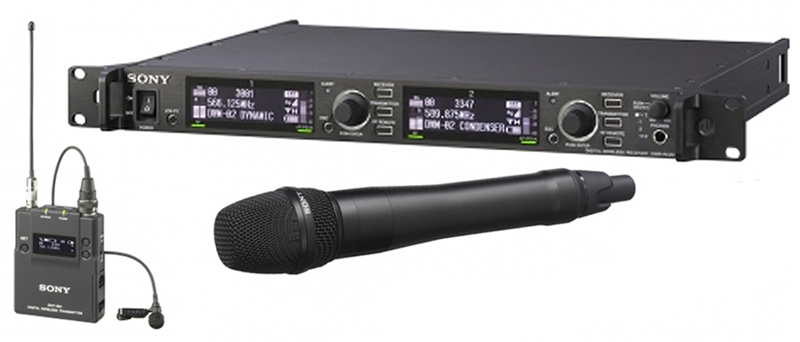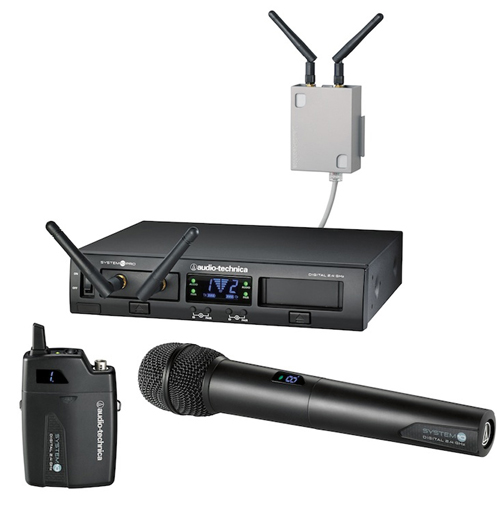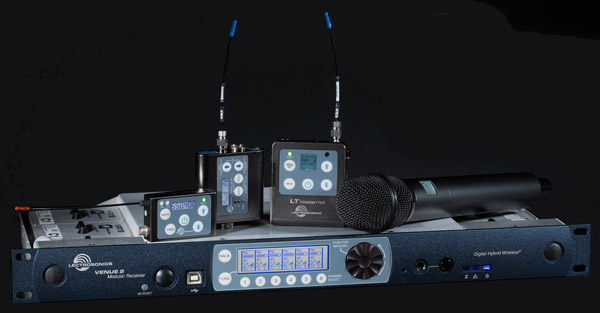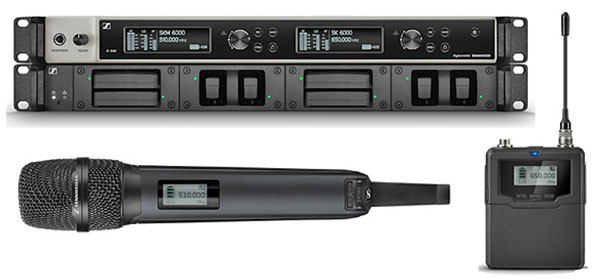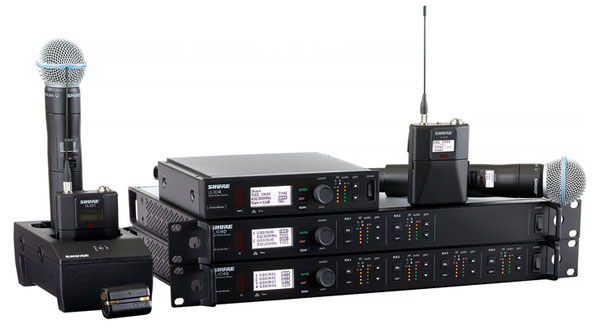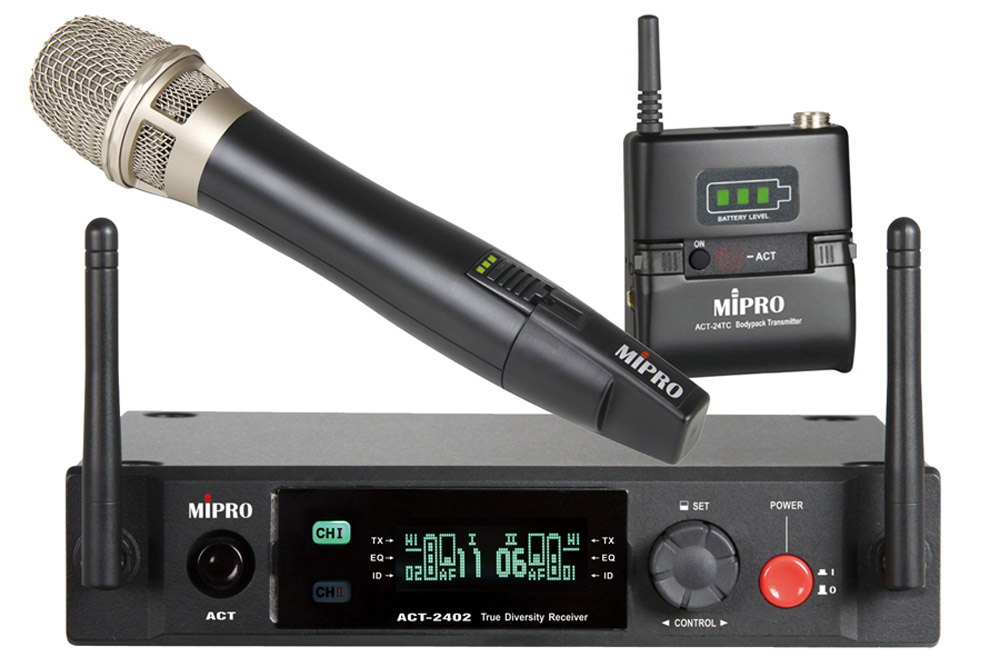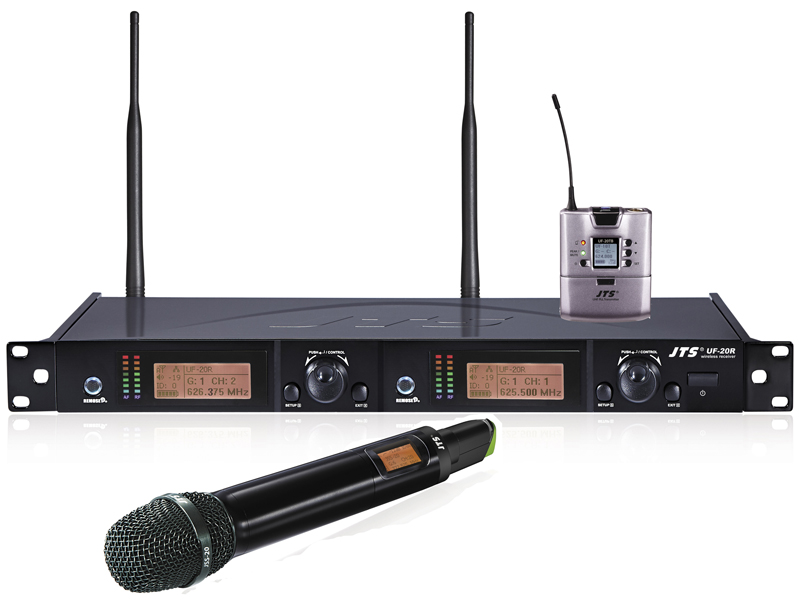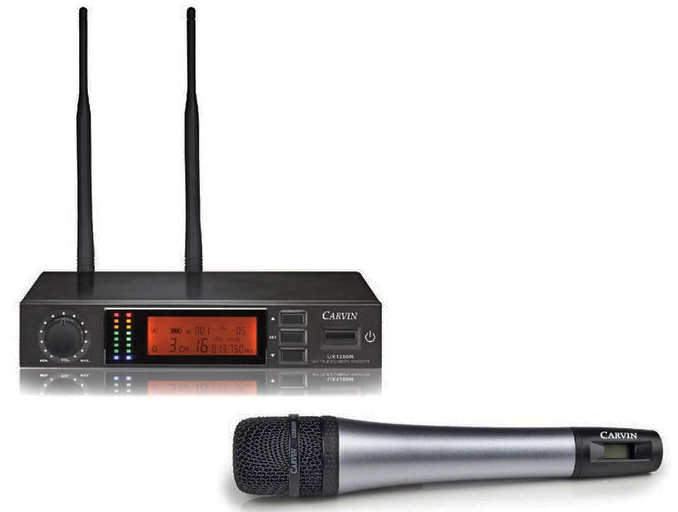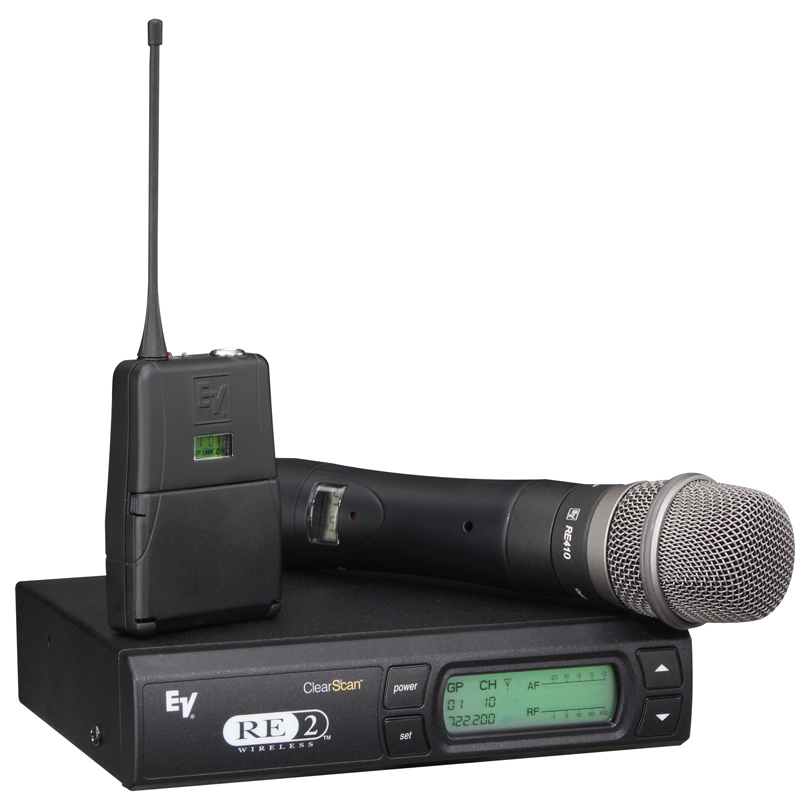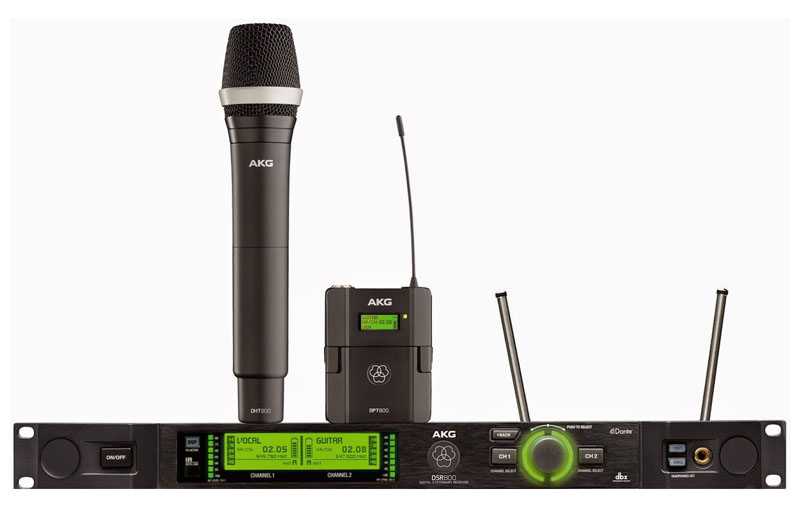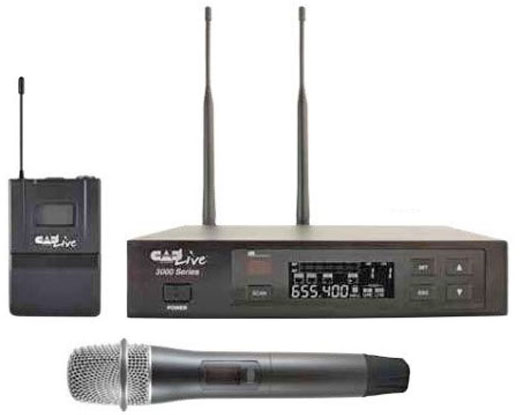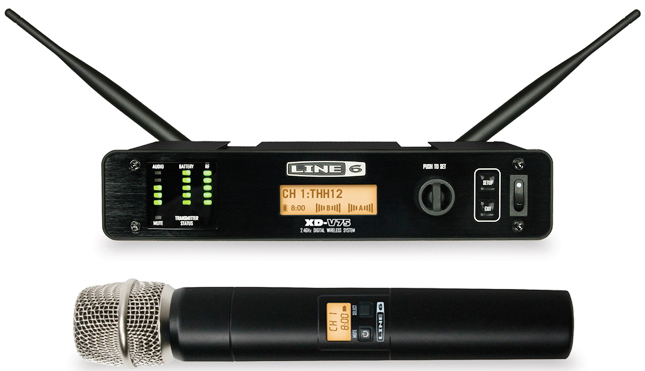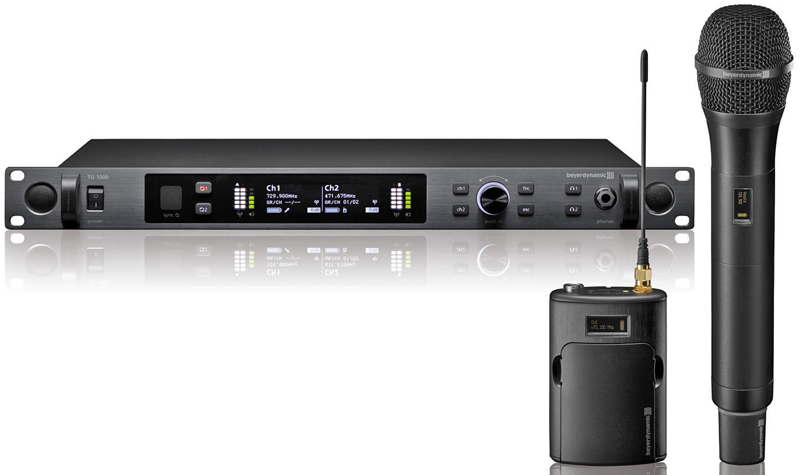Time has definitely not stood still with wireless microphone system development, even under the cloud of the long-running auction process of the radio frequency (RF) spectrum by the Federal Communications Commission (FCC). And thankfully, with the conclusion of final round of that process, which began in the spring of 2016, the way forward is now much clearer.
Briefly, the auction resulted in the loss of 614 to 698 MHz (UHF channels 38-51), so the remaining usable bands will be from 470 to 608 MHz (UHF channels 14-36), joined by 174 to 216 MHz (VHF channels 7-13). There will be some slices of spectrum in the guard bands and mid-band gap within the 600 MHz band offering limited access, but only under specific restrictions.
As of now, there’s a 39-month countdown to the time all wireless system operation above 614 MHz must cease with the exception of those systems compliant with the rules of the guard bands and mid-band gap. The good news is that users will still have up to three years to continue using existing gear in the affected blocks and bands, depending on when the new services start up in each market.
Also note that for now, wireless systems operating between 614 and 698 MHz are still legal to manufacture, sell and use in North America. However, it’s certainly not too early to begin planning and budgeting for replacement or re-tuning (where applicable) of these systems during the next year or two.
Fortunately, all reputable wireless manufacturers have been planning for this event by designing systems with wide tuning ranges, flexible operation, and good receiver filtering. Many transmitters also offer user-selectable RF power that can be quite helpful in tailoring for high-channel-count and short-distance applications.
In addition, much work has gone into enhancing the efficient use of available spectrum, so that more wireless system channels can work together without interference within a particular 6 MHz television channel or other patch of available spectrum. Key to this spectral efficiency is digital transmission of the signal between the transmitter and receiver, as digital systems can be designed to offer important tradeoffs such as range, channel density and audio fidelity.
Even further, more manufacturers now offer a range of options in the VHF bands, and there are also systems available in alternate bands, including 1.8 GHz, 2.4 GHz, 5 GHz, 6 GHz, and other bands as well. In general, these alternative bands are best used for specialized purposes because higher frequencies don’t have the same propagation characteristics as the VHF and lower UHF bands.
The introduction of digital wireless has also coincided with a push toward digital audio networking and computer control within the audio equipment chain. Touring-class wireless is likely to have the ability to be remotely monitored and controlled, and with integrated AES/EBU or (Audinate) Dante receiver outputs can offer the option of keeping the signal in the digital domain from the stage through the console to the loudspeaker system.
Some of these systems have also added technologies for increasing reliability and resistance to dropouts, transmitting the same signal on more than one frequency (frequency diversity) and transmitting the same audio data in different time slots (time diversity), with algorithms at the receiver reassembling the digital information into coherent order.
Because the emitted signal from the transmitter is digital and the source audio has been converted to data, the audio can be encrypted before it is sent – and therefore protected from being monitored by anything other than its assigned receiver. Security is now readily available for applications that require it. Encryption at levels of 128-bit and 256-bit is common, and one newly introduced system has upped the ante to 512-bit encryption.
Attention has also been directed toward placing antennas closer to the performing area where the transmitters are in use. One manufacturer has even developed the ability to remove its modular receivers from the chassis bays and remotely mount them (with antennas attached), running a Cat-5/6 cable between these small receiver modules and the receiver chassis. This helps support the use of lower powered transmitters.
Some of the available antenna systems are active, boosting the received signal level before it travels to the receiver via coax cable. Directional antennas accomplish double duty, with increased sensitivity aimed toward the desired signals and lower sensitivity at the rear to attenuate interfering RF signals within their null zones.
Several manufacturers also offer very good, and constantly updated, software packages that help to manage and monitor wireless system performance over a network, from pre-show planning through post-performance analysis. Further, companies such as Kaltman Creations and RF Venue are another growing resource, offering tools that can ease more complex wireless applications.
While it’s pretty much a certainty that users will always be dealing with complications when it comes to wireless, the latest systems detailed in our round-up that follows are more powerful and flexible than ever before. Expect that trend to continue.
Audix Performance Series
RF Transmission: Analog
Frequency Band: UHF, 522 MHz – 586 MHz (R61/62 receivers)
Receiver Bandwidth: 64 MHz (R61/62)
Frequency Agility/RF Search: Auto scan and sync of 207 pre-coordinated frequencies Diversity Scheme: Dual tuner, true diversity
Receiver Format: 1/2RU 1-channel, 1RU 2-channel
Receiver Outputs: Analog (XLR & 1/4-inch)
Audio Bandwidth: 45 Hz – 18 kHz
Sampling Rate: N/A
Transmitter RF Power: Variable, 10 and 40 mW
Tx/Rx Communication: Pilot tone
Control/Interfacing: N/A
Of Note: Modular interchangeable capsules for OM Series and VX5 vocal mics with HH; 16 systems (conservatively) can be used simultaneously; 2,560 individual frequencies available for manual tuning.
Audio-Technica System 10 PRO
RF Transmission: Digital
Frequency Band: 2.4 GHz ISM
Frequency Agility/RF Search: Automatic
Diversity Scheme: Frequency, time and space diversity
Receiver Format: Half-Rack Chassis (ATW-RC13); Receiver Unit (ATW-RU13)
Receiver Outputs: Analog (balanced XLR; unbalanced 1/4-inch)
Audio Bandwidth: 20 Hz–20 kHz
Audio Sampling: 24 bit/48 kHz
Latency: 3.8 ms
Transmitter RF Power: 10 mW
Tx/Rx Communication: Duplex
Of Note: Removable receiver units can be mounted remotely using Ethernet cable; up to five chassis (10 receiver units) can be linked and used simultaneously; available in dual- and single-channel systems with handheld and/or lavalier configurations.
Lectrosonics Venue 2
RF Transmission: Digital Hybrid
Frequency Band: UHF (multiple bands between 470 – 691 MHz)
Receiver Bandwidth: 75 MHz
Frequency Agility/RF Search: Agile; scan and spectrum analyzer mode
Diversity Scheme: Antenna phase switching or ratio true diversity
Receiver Format: 1RU master unit with up to 6 channel modules
Receiver Outputs: Analog
Audio Bandwidth: 40 Hz – 20 kHz (+/-1 dB)
Sampling Rate: 24-bit/88 kHz
Latency: < 3.0 ms
Transmitter RF Power: Variable; 20/50/100/250 mW, depending on transmitter
Tx/Rx Communication: Via infrared
lectrosonics.com
Sennheiser Digital 6000
RF Transmission: Digital
Frequency Band: UHF, 470 – 714 MHz
Receiver Bandwidth: 244 MHz
Frequency Agility/RF Search: Agile; scanning and spectrum analyzer function
Diversity Scheme: True Bit Diversity
Receiver Format: 1RU/2-channel
Receiver Outputs: Analog, AES digital, Dante version also available
Audio Bandwidth: 30 Hz – 20 kHz (+/-1.5 dB)
Sampling Rate: 24-bit/variable 44, 48, 88, 96 kHz
Latency: 3 ms
Transmitter (SKM 6000 HH) RF Power: 25 mW (RMS), 50 mW (peak)
Tx/Rx Communication: IR sync
Control/Interfacing: Ethernet with WSM software
Of Note: AES 256-bit encryption; HD and LR (long-range) transmission modes;
integrated antenna splitter for cascading of up to 8 systems; automatic frequency setup; 32 RF pre-selection filters for suppression of interference
Shure ULX-D
RF Transmission: Digital
Frequency Bands: UHF, several bands between 470 – 932 MHz; VHF, 174-216 MHz
Receiver Bandwidth: UHF, 64 MHz; VHF, 42 MHz
Frequency Agility/RF Search: Agile; scanning
Diversity Scheme: Predictive switching diversity
Receiver Format: Single-channel (half-rack), dual- and quad-channel (1RU)
Receiver Outputs: Analog; Dante digital audio (dual- and quad-channel)
Audio Bandwidth: 20 Hz – 20 kHz (+/-1 dB)
Sampling Rate: 24-bit/48 kHz
Latency: < 2.9 ms
Transmitter RF Power: Variable, 1/10/20 mW
Tx/Rx Communication: IR sync
Control/Interfacing: Ethernet networking with Wireless Workbench software; AMX/Crestron control
Of Note: AES 256-bit encryption; high-density mode for up to 47 channels in 6 MHz of spectrum; now also available in VHF version, with several VHF-ready accessories (i.e., antennas) also offered.
shure.com
MIPRO ACT 2400 Series
RF Transmission: Digital
Frequency Band: 2.4 GHz ISM
Receiver Bandwidth: 64 MHz
Frequency Agility/RF Search: Each channel has 4 preset hopping frequencies; AutoScan scanning
Diversity Scheme: Digital diversity
Receiver Format: 1RU/single- and dual-channel
Receiver Outputs: Analog (balanced XLR, unbalanced 1/4-inch)
Audio Bandwidth: 20 Hz – 20 kHz (-2 dB)
Sampling Rate: 24-bit/44.1 kHz
Latency: < 4 ms
Transmitter RF Power: Variable, 2/10 mW (country dependent)
Tx/Rx Communication: ACT Sync
Of Note: 12 compatible simultaneous channel operations at distances up to 330 feet; 4-frequency FSK (frequency shift key) modulation circuitry with range, RF signal stability, and channel density; system includes MP-80 smart charging cradle.
avlex.com
mipro.com.tw
JTS UF-20
RF Transmission: Analog
Frequency Band: UHF, various bands from 470 – 960 MHz (530 – 605 MHz in U.S.)
Receiver Bandwidth: 75 MHz
Frequency Agility/RF Search: Agile with scanning capabilities
Diversity Scheme: True Diversity
Receiver Format: Half-rack/1-channel
Receiver Outputs: Analog
Audio Bandwidth: 50 Hz – 18 kHz
Sampling Rate: N/A
Latency: N/A
Transmitter RF Power: Variable, 10 mW/50 mW
Tx/Rx Communication: REMOSET ID Pairing
Control/Interfacing: N/A
Of Note: Antenna cascading across up to 10 receivers; interchangeable microphone capsules; communication of transmitter status includes RF power, sensitivity setting, low-cut filter setting, and user name.
Carvin UX1200MC
RF Transmission: Analog
Frequency Band: UHF, 506 MHz – 542 MHz
Receiver Bandwidth: 36 MHz
Frequency Agility/RF Search: Agile; coordinated frequency groups
Diversity Scheme: True Diversity
Receiver Format: Half-rack/1-channel
Receiver Outputs: Analog
Audio Bandwidth: 50 Hz – 16 kHz
Sampling Rate: N/A
Latency: N/A
Transmitter RF Power: 10 or 50 mW (selectable)
Tx/Rx Communication: Manual selection
Control/Interfacing: N/A
Of Note: Dual independent RF receivers on the same frequency, with automatic logic circuitry continuously selecting the superior signal; 1,441 user-selectable frequencies or select by six groups of 23 channels; up to 16 systems can be used simultaneously.
Electro-Voice RE2-PRO
RF Transmission: Analog
Frequency Band: UHF (614 – 642 MHz, 648 – 678 MHz)
Receiver Bandwidth: 28 MHz
Frequency Agility/RF Search: Proprietary Auto-ClearScan
Diversity Scheme: True diversity
Receiver Format: Half-rack/1-channel
Receiver Outputs: Analog
Audio Bandwidth: 50 Hz – 15 kHz (+/-2 dB)
Sampling Rate: N/A
Latency: N/A
Transmitter RF Power: HH – 30 mW; BP – Variable, 5/50 mW
Tx/Rx Communication: N/A
Control/Interfacing: N/A
Of Note: Programmable, frequency-agile system; frequencies selectable in 25 kHz increments; unique mode that is optimized for guitar; receiver includes all necessary rack-mount hardware.
AKG DMS800
RF Transmission: Digital
Frequency Band: UHF (Various bands ranging between 548 – 832 MHz)
Receiver Bandwidth: 150 MHz
Frequency Agility/RF Search: Agile; scan and spectrum analyzer functions
Diversity Scheme: True diversity
Receiver Format: 1RU/2-channel
Receiver Outputs: Analog; Dante and AES/EBU digital
Audio Bandwidth: 25 Hz – 20 kHz (+/-3 dB)
Sampling Rate: 24-bit/44 kHz
Latency: < 4 ms
Transmitter RF Power: Variable, 10/20/30/50 mW
Tx/Rx Communication: IR sync
Of Note: 512-bit encryption; Dante and AES/EBU digital outputs; optional network remote control for frequency coordination and multi-channel system monitoring; available in sets customized for vocalists and performers.
akg.com
CAD Audio CADLive 3000 Series
RF Transmission: Analog
Frequency Band: UHF (580 – 600 MHz, 655 – 679 MHz)
Receiver Bandwidth: 44 MHz
Frequency Agility/RF Search: Agile; proprietary ScanLink to select optimum channel
Diversity Scheme: True diversity
Receiver Format: Half-rack/1-channel
Receiver Outputs: Analog
Audio Bandwidth: 40 Hz – 15 kHz
Sampling Rate: N/A
Latency: N/A
Transmitter RF Power: Variable 10/30/50 mW
Tx/Rx Communication: N/A
Control Interfacing: N/A
Of Note: Proprietary CADLock helps eliminate unauthorized transmissions in signal path; HH outfitted with D90 supercardioid dynamic capsule; bodypack transmitters include Equitek E19 earworn and E29 lavalier mics.
Line 6 XD-V75
RF Transmission: Digital
Frequency Band: 2.4 GHz
Receiver Bandwidth: 75 MHz
Frequency Agility/RF Search: Agile; Scanning
Diversity Scheme: Frequency diversity; space diversity
Receiver Format: Half-rack/1-channel
Receiver Outputs: Analog
Audio Bandwidth: 10 Hz – 20 kHz (-2.5 dB)
Sampling Rate: 24-bit/44 kHz
Latency: < 2.9 ms
Transmitter RF Power: Variable, 3.3/10 mW
Tx/Rx Communication: IR sync
Control/Interfacing: N/A
Of Note: EQ and mic capsule modeling; encrypted transmission; select from up to 14 channels; compatible with many other components making it feasible to combine handhelds, lavaliers, headsets and instruments within same system.
line6.com
beyerdynamic TG 1000
RF Transmission: Digital
Frequency Band: UHF (470 – 789 MHz; available at 470 – 698 MHz)
Receiver Bandwidth: 319 MHz
Frequency Agility/RF Search: Agile; scanning
Diversity Scheme: True diversity
Receiver Format: 1RU/2-channel
Receiver Outputs: Analog
Audio Bandwidth: 20 Hz – 20 kHz
Sampling Rate: 24-bit/44 kHz
Latency: < 2.1 ms
Transmitter RF Power: Variable, 10/50 mW
Tx/Rx Communication: IR sync
Control/Interfacing: IP-based control using Chameleon software; control via computer, tablet, smart phone
Of Note: Switchable encryption; antenna cascading through 12 receivers; company also offers the Opus 910 Series with receiver chassis housing one, two, and four channels depending on model.
north-america.beyerdynamic.com
Sony DWX Series
RF Transmission: Digital
Frequency Band: UHF (three bands between 470 – 698 MHz)
Receiver Bandwidth: 72 MHz
Frequency Agility/RF Search: Agile; scan and spectrum analyzer function
Diversity Scheme: True diversity
Receiver Format: 1RU/2-channel
Receiver Outputs: Analog; AES3 digital
Audio Bandwidth: 20 Hz – 22 kHz
Sampling Rate: 24-bit/48 kHz
Latency: < 3.4 ms
Transmitter RF Power: Variable, 1/10/50 mW
Tx/Rx Communication: 2.4 GHz bi-directional link
Control/Interfacing: Ethernet with Wireless Studio 3.0 software
Of Note: Proprietary encryption; transmitter “sleep” mode; thread-on capsules on HH; ENG-format receiver available.
pro.sony.com



